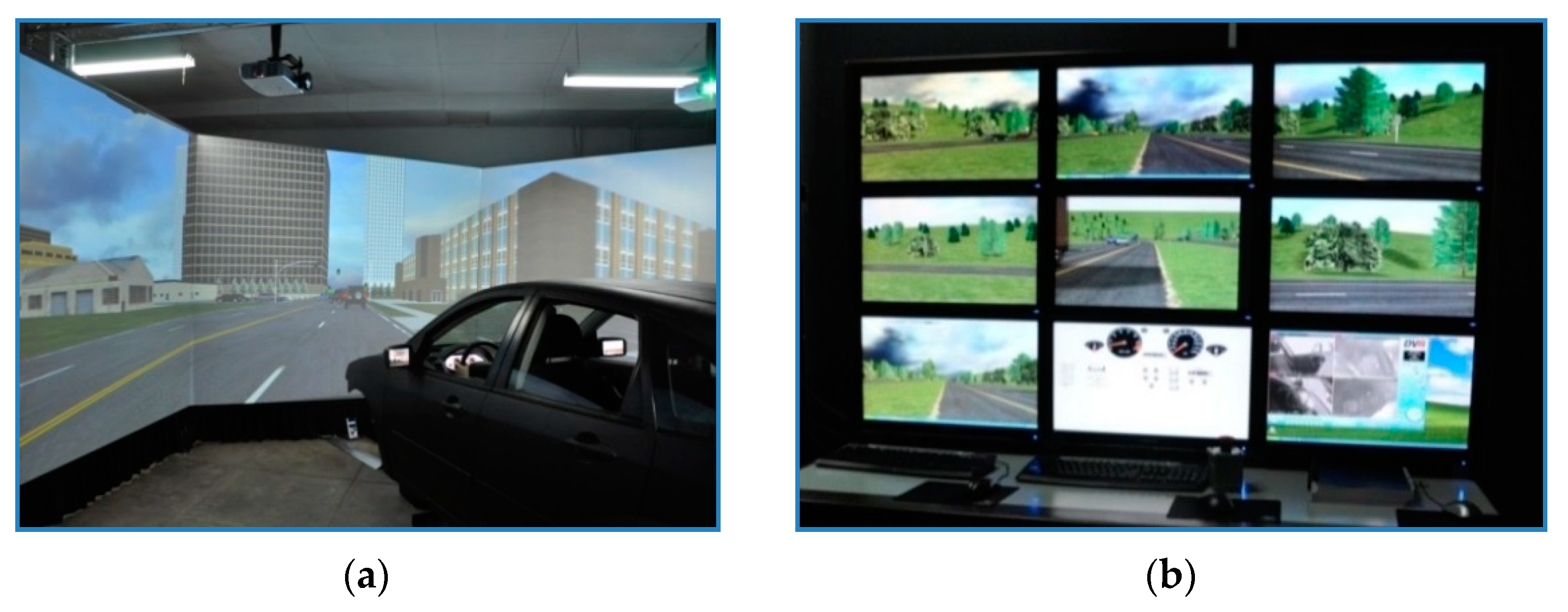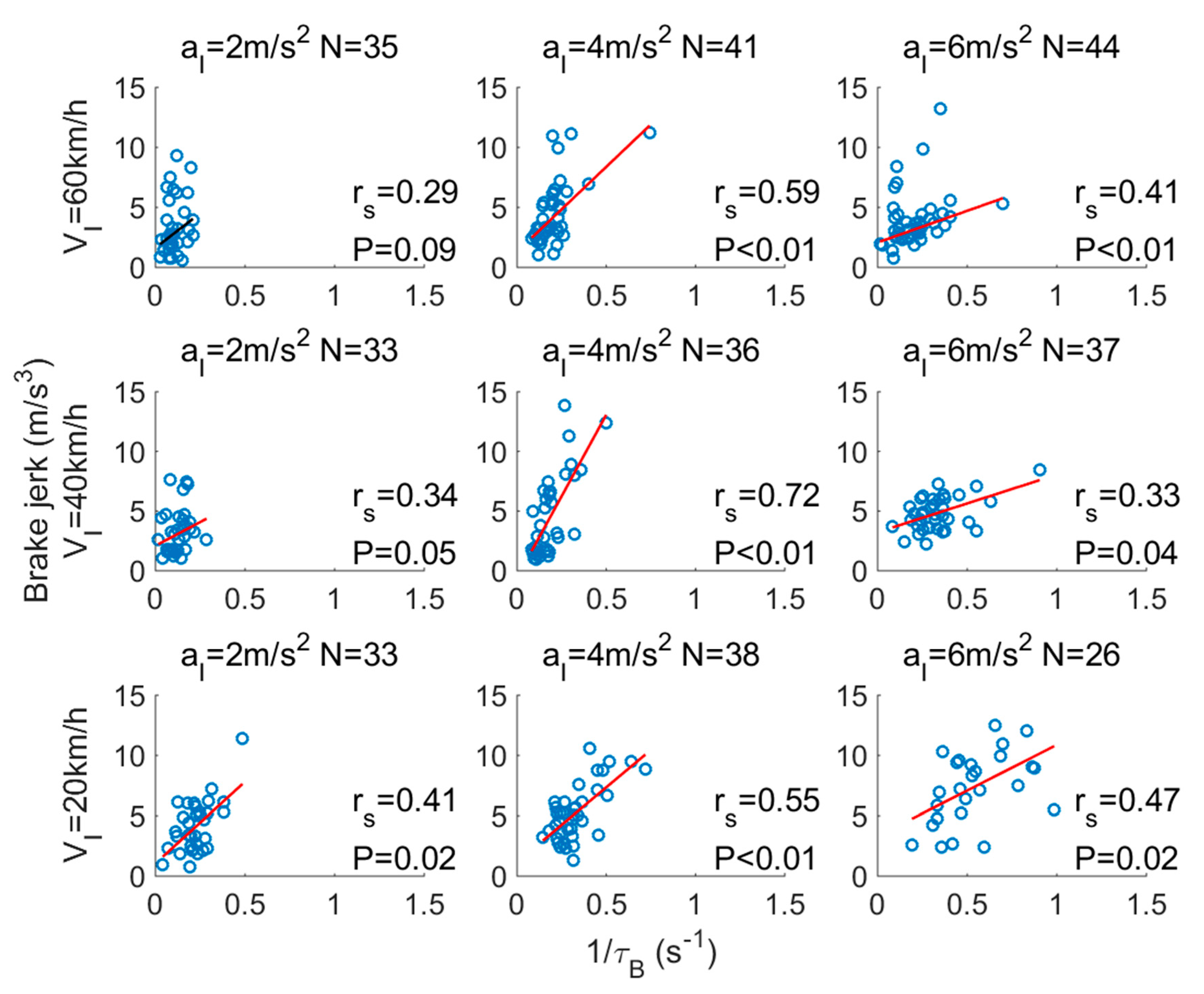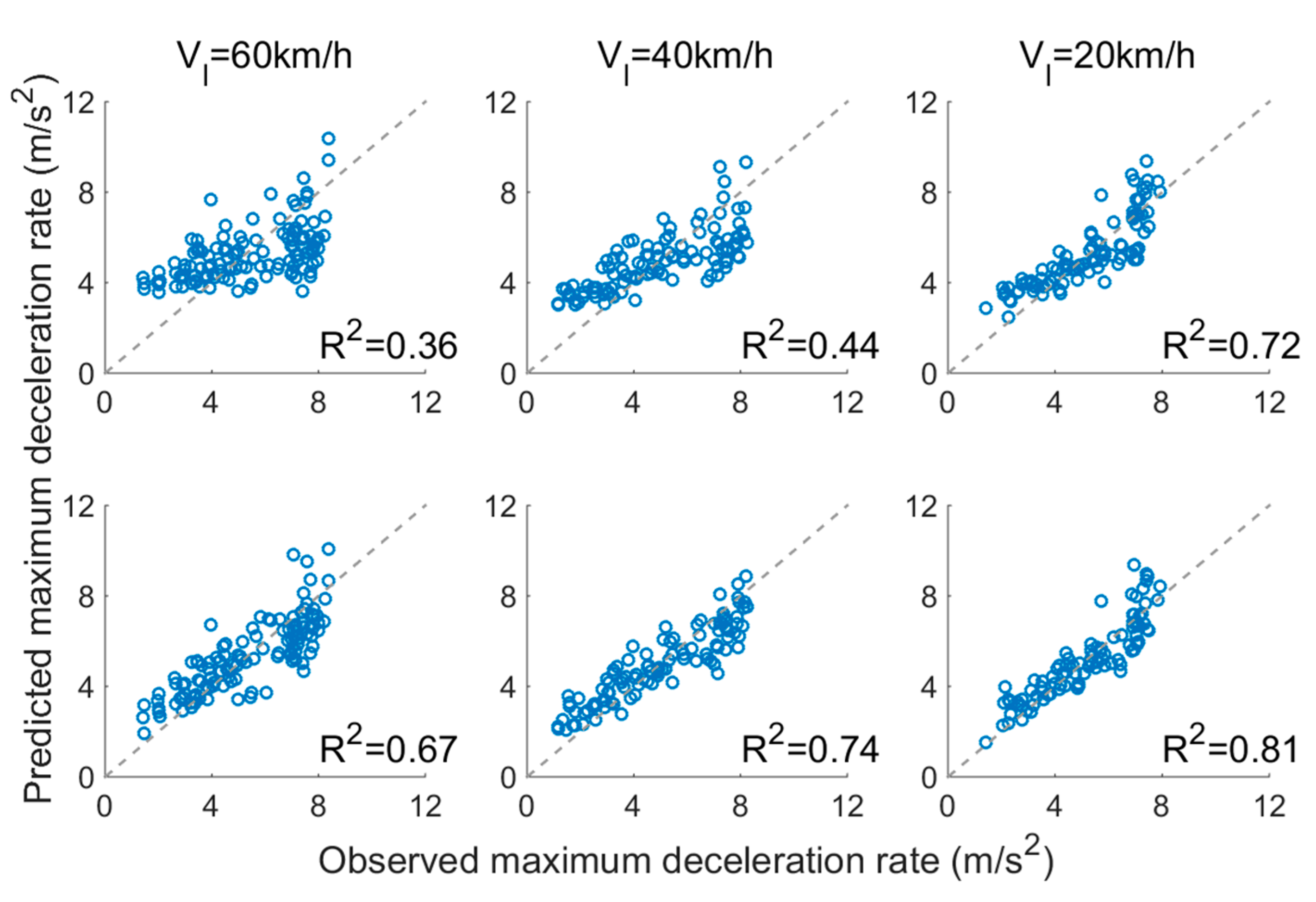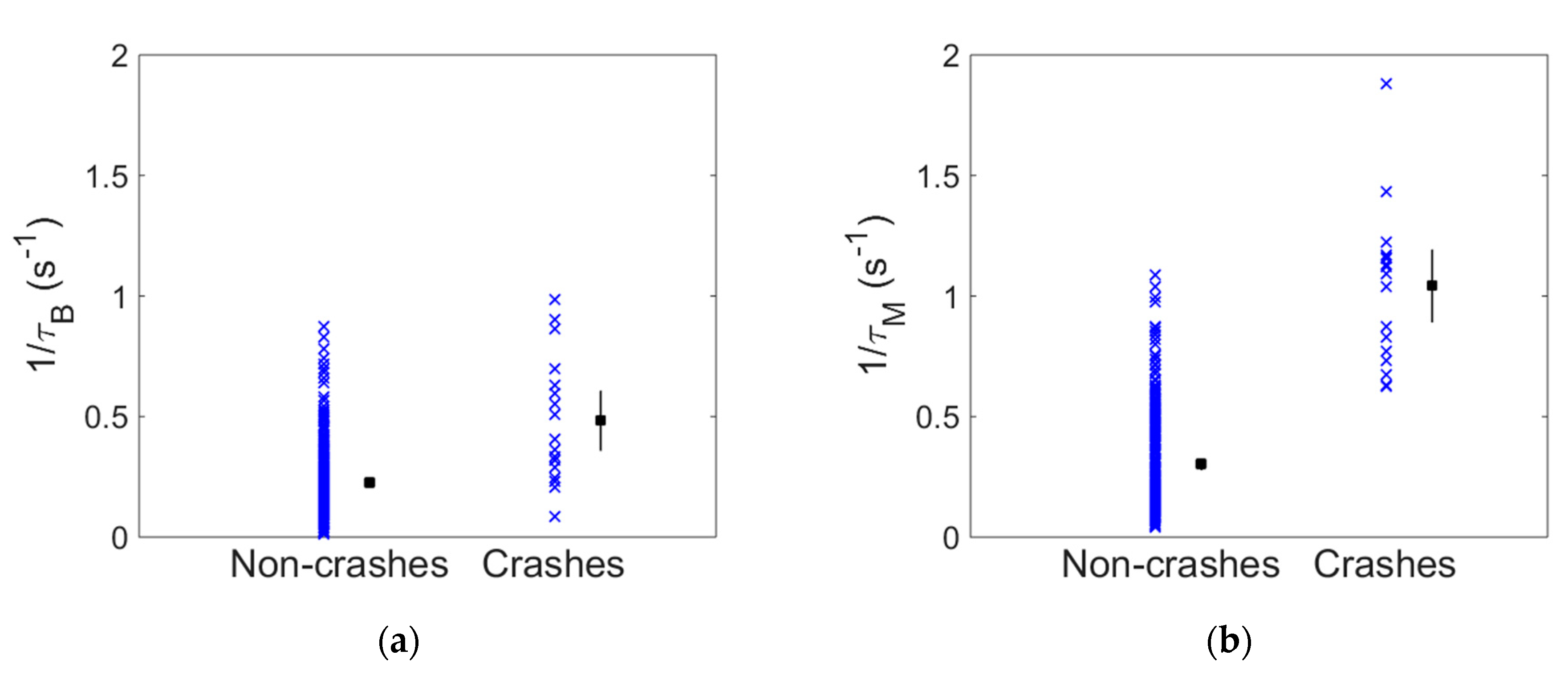Effect of Situation Kinematics on Drivers’ Rear-End Collision Avoidance Behaviour—A Combined Effect of Visual Looming, Speed, and Distance Analysis
Abstract
1. Introduction
2. Methods
2.1. Subjects
2.2. Equipment
2.3. Scenario Design
2.4. Visual Looming-Based Measures
2.5. Model and Data for Analysis
3. Results
3.1. The Spearman’s Nonparametric Test between and Deceleration Behaviour
3.2. Prediction of Brake Jerk and Maximum Deceleration Rate
3.3. Logistic Analysis of Rear-End Collision Probability
4. Conclusions
Author Contributions
Funding
Institutional Review Board Statement
Informed Consent Statement
Data Availability Statement
Conflicts of Interest
References
- World Health Organization. Global Status Report on Road Safety: Supporting a Decade of Action; World Health Organization: Geneva, Switzerland, 2013. [Google Scholar]
- Kusano, K.D.; Gabler, H.C. Pre-crash scenarios for determining target populations of active safety systems. In Proceedings of the 23rd International Technical Conference on the Enhanced Safety of Vehicles (ESV), Seoul, Republic of Korea, 27–30 May 2013. [Google Scholar]
- Montgomery, J.; Kusano, K.D.; Gabler, H.C. Age and gender difference in time to collision braking from the 100-car naturalistic driving study. Traffic Inj. Prev 2014, 15, S15–S20. [Google Scholar] [CrossRef]
- Barrett, G.V.; Kobayashi, M.; Fox, B.H. Feasibility of studying driver reaction to sudden pedestrian emergencies in an automobile simulator. Hum. Factors 1968, 10, 19–26. [Google Scholar] [CrossRef]
- McGehee, D.V.; Mazzae, E.N.; Baldwin, G.H.S.; Grant, P.; Simmons, C.J.; Hankey, J.; Forkenbrock, G. Examination of Drivers’ Collision Avoidance Behavior Using Conventional and Antilock Brake Systems on the IOWA Driving Simulator; Technical Report; University of Iowa: Iowa City, IA, USA, 1999. [Google Scholar]
- Lee, J.D.; McGehee, D.V.; Brown, T.; Reyes, M.L. Collision warning, driver distraction, and driver response to rear-end collisions in a high-fidelity driving simulator. Hum. Factors 2002, 44, 314–334. [Google Scholar] [CrossRef]
- Muttart, J.W. Development and Evaluation of Driver Response Time Predictors Based upon Meta-Analysis; Technical Paper 2003-01-0885; SAE International: Warrendale, PA, USA, 2003. [Google Scholar]
- Muttart, J.W. Quantifying driver response times based upon research and real life data. In Proceedings of the Third International Driving Symposium on Human Factors in Driver Assessment, Training and Vehicle Design, Rockport, ME, USA, 27–30 June 2005. [Google Scholar]
- Fischer, M.; Barkley, R.A.; Smallish, L.; Fletcher, K. Hyperactive children as young adults: Driving abilities, safe driving behavior, and adverse driving outcomes. Accid. Anal. Prev. 2007, 39, 94–105. [Google Scholar] [CrossRef]
- Li, X.; Yan, X.; Wu, J.; Radwan, E.; Zhang, Y. A rear-end collision risk assessment model based on drivers’ collision avoidance process under influences of cell phone use and gender—A driving simulator based study. Accid. Anal. Prev. 2016, 97, 1–18. [Google Scholar] [CrossRef]
- Wang, X.; Zhu, M.; Chen, M.; Tremont, P. Drivers’ rear end collision avoidance behaviors under different levels of situational urgency. Transp. Res. Part C 2016, 71, 419–433. [Google Scholar] [CrossRef]
- Fambro, D.B.; Koppa, R.J.; Picha, D.L.; Fitzpatrick, K. Driver braking performance in stopping sight distance situations. Transp. Res. Rec. 2000, 1701, 9–16. [Google Scholar] [CrossRef]
- Markkula, G.; Engström, J.; Lodin, J.; Bargman, J.; Victor, T. A farewell to brake reaction times? Kinematics dependent brake response in naturalistic rear-end emergencies. Accid. Anal. Prev. 2016, 95, 209–226. [Google Scholar] [CrossRef]
- Kusano, K.; Chen, R.; Gabler, H. Effect of driving context on time to collision at brake application during car following. In Proceedings of the FAST-Zero’15: 3rd International Symposium on Future Active Safety Technology toward Zero Traffic Accidents, Gothenburg, Sweden, 9–11 September 2015. [Google Scholar]
- Kusano, K.D.; Chen, R.; Montgomery, J.; Gabler, H.C. Population distributions of time to collision at brake application during car following from naturalistic driving data. J. Saf. Res. 2015, 54, 95.e29–104. [Google Scholar] [CrossRef]
- Hang, J.; Yan, X.; Li, X.; Duan, K.; Yang, J.; Xue, Q. An improved automated braking system for rear-end collisions: A study based on a driving simulator experiment. J. Saf. Res. 2022, 80, 416–427. [Google Scholar] [CrossRef]
- Lee, D.N. A theory of visual control of braking based on information about time-to-collision. Perception 1976, 5, 437–459. [Google Scholar] [CrossRef]
- Hassenstein, B.; Hustert, R. Hiding responses of locusts to approaching objects. J. Exp. Biol. 1999, 202, 1701–1710. [Google Scholar] [CrossRef]
- Franconeri, S.L.; Simons, D.J. Moving and looming stimuli capture attention. Percept. Psychophys. 2003, 65, 999–1010. [Google Scholar] [CrossRef]
- Kondoh, T.; Yamamura, T.; Kitazaki, S.; Kuge, N.; Boer, E.R. Identification of visual cues and quantification of drivers’ perception of proximity risk to the lead vehicle in car-Following situations. J. Mech. Syst. Transp. Logist. 2008, 1, 170–180. [Google Scholar] [CrossRef]
- Jurecki, R.S.; Stanczyk, T.L. Driver model for the analysis of pre-accident situations. Veh. Syst. Dyn. 2009, 47, 589–612. [Google Scholar] [CrossRef]
- Jurecki, R.S.; Stanczyk, T.L. Driver reaction time to lateral entering pedestrian in a simulated crash traffic situation. Transp. Res. Part F 2014, 27, 22–36. [Google Scholar] [CrossRef]
- Lamble, D.; Kauranen, T.; Laakso, M.; Summala, H. Cognitive load and detection thresholds in car following situations: Safety implications for using mobile (cellular) telephones while driving. Accid. Anal. Prev. 1999, 31, 617–623. [Google Scholar] [CrossRef]
- Maddox, M.E.; Kiefer, A. Looming threshold limits and their use in forensic practice. Proc. Hum. Factors Ergon. Soc. Annu. Meet. 2012, 56, 700–704. [Google Scholar] [CrossRef]
- Kiefer, R.J.; Cassar, M.T.; Flannagan, C.A.; LeBlanc, D.J.; Palmer, M.D.; Deering, R.K.; Shulman, M.A. Forward Collision Warning Requirements Project Final Report–Task 1; US Department of Transportation: Washington, DC, USA, 2003.
- Kiefer, R.J.; LeBlanc, D.J.; Flannagan, C.A. Developing an inverse time-to-collision crash alert timing approach based on drivers’ last-second braking and steering judgments. Accid. Anal. Prev. 2005, 37, 295–303. [Google Scholar] [CrossRef]
- Fajen, B.R. Calibration, information and control strategies for braking to avoid a collision. J. Exp. Psychol. Hum. Percept. Perform. 2005, 3, 480–501. [Google Scholar] [CrossRef]
- Fajen, B.R. Perceptual learning and the visual control of braking. Percept. Psychophys. 2008, 70, 1117–1129. [Google Scholar] [CrossRef]
- Treiber, M.; Kesting, A. Chapter 11: Car-Following models based on driving strategies. In Traffic Flow Dynamics, 1st ed.; Springer: Berlin, Germany, 2013; pp. 181–204. [Google Scholar]
- Xue, Q.; Yan, X.; Zhao, Y.; Zhang, Y. The role of situation criticality in affecting the effect of cognitive load on drivers’ brake responses: A driving simulator based study. J. Adv. Transp. 2020, 2020, 8886541. [Google Scholar] [CrossRef]
- Xue, Q.; Markkular, G.; Yan, X.; Merat, N. Using perceptual cues for brake response to a lead vehicle: Comparing threshold and accumulator models of visual looming. Accid. Anal. Prev. 2018, 118, 114–124. [Google Scholar] [CrossRef]
- Tso, G.K.F.; Guan, J. A multilevel regression approach to understand effects of environment indicators and household features on residential energy consumption. Energy 2014, 66, 722–731. [Google Scholar] [CrossRef]
- Markkula, G. Modeling driver control behavior in both routine and near-accident driving. Proc. Hum. Factors Ergon. Soc. Annu. Meet. 2014, 58, 879–883. [Google Scholar] [CrossRef]
- Hogema, J.H. Modelling of individual car following behavior. In XV European Annual Conference on Human Decision Making and Manual Control; TNO: The Hague, The Netherlands, 1996. [Google Scholar]
- Brackstone, M.; Sultan, B.; McDonald, M. Motorway driver behaviour: Studies on car following. Transp. Res. Part F 2002, 5, 31–46. [Google Scholar] [CrossRef]
- Duan, J.Y.; Li, Z.Z.; Salvendy, G. Automatic imitation of risky behavior: A study of simulated driving in China. Traffic Inj. Prev. 2012, 13, 442–449. [Google Scholar] [CrossRef]
- Engström, J.; Markkula, G.; Xue, Q.; Merat, N. Simulating the effect of cognitive load on braking responses in lead vehicle braking scenarios. IET Intell. Transp. Syst. 2018, 12, 427–433. [Google Scholar] [CrossRef]






| Notations | Definitions | |
|---|---|---|
| Vehicle state | W | the width of the lead vehicle |
| d | the distance from driver’s eyes to the tail of the lead vehicle | |
| the relative speed of the two vehicles | ||
| Optical variables | collected when drivers in the simulator started braking | |
| collected when drivers in the simulator reached their maximum deceleration rate |
| Observations | Mixed Model | ||||
|---|---|---|---|---|---|
| Estimate (95% CI) | T Test | R2 | |||
| brake jerk jB | N = 323 | intercept | 3.34 [2.43 4.25] | 7.12 | 0.65 |
| 7.02 [5.58 8.45] | 9.61 | ||||
| DB | −0.08 [−0.11 −0.05] | −5.14 | |||
| Vf | 0.08 [0.02 0.13] | 2.82 | |||
| 1.24 [0.95 1.60] | -- | ||||
| 1.58 [1.45 1.72] | -- | ||||
| maximum deceleration rate am | model A N = 323 | intercept | 1.52 [0.76 2.28] | 3.95 | 0.48 |
| 3.82 [2.51 5.13] | 5.75 | ||||
| jB | 0.34 [0.26 0.42] | 8.68 | |||
| DB | −0.03 [−0.05 −0.00] | −2.16 | |||
| Vf | 0.14 [0.09 0.18] | 6.09 | |||
| 0 [--] | -- | ||||
| 1.41 [1.31 1.53] | -- | ||||
| model B N = 323 | intercept | 1.90 [1.29 2.51] | 6.14 | 0.73 | |
| 3.41 [2.85 3.97] | 12.00 | ||||
| jB | 0.28 [0.22 0.35] | 9.06 | |||
| DM | −0.06 [−0.08 −0.04] | −4.99 | |||
| Vf | 0.14 [0.11 0.18] | 8.45 | |||
| 0.67 [0.49 0.92] | -- | ||||
| 1.04 [0.95 1.13] | -- | ||||
| Estimate | S.E. | T Test | R2 | ||
|---|---|---|---|---|---|
| model A | intercept | −10.92 | 3.80 | −2.87 2 | 0.62 |
| 27.40 | 7.73 | 3.55 2 | |||
| jB | −2.41 | 0.64 | −3.79 2 | ||
| DB | −0.22 | 0.08 | −2.71 2 | ||
| am | 0.88 | 0.33 | 2.66 2 | ||
| Vf | 0.54 | 0.21 | 2.63 2 | ||
| model B | intercept | −9.40 | 5.67 | −1.69 | 0.81 |
| jB | −1.31 | 0.50 | −2.62 2 | ||
| am | 0.54 | 0.54 | 0.99 | ||
| 14.48 | 5.12 | 2.83 2 | |||
| DM | −0.68 | 0.30 | −2.24 1 | ||
| Vf | 0.43 | 0.21 | 2.06 1 |
Publisher’s Note: MDPI stays neutral with regard to jurisdictional claims in published maps and institutional affiliations. |
© 2022 by the authors. Licensee MDPI, Basel, Switzerland. This article is an open access article distributed under the terms and conditions of the Creative Commons Attribution (CC BY) license (https://creativecommons.org/licenses/by/4.0/).
Share and Cite
Xue, Q.; Ouyang, X.; Zhao, Y.; Guo, W. Effect of Situation Kinematics on Drivers’ Rear-End Collision Avoidance Behaviour—A Combined Effect of Visual Looming, Speed, and Distance Analysis. Sustainability 2022, 14, 15103. https://doi.org/10.3390/su142215103
Xue Q, Ouyang X, Zhao Y, Guo W. Effect of Situation Kinematics on Drivers’ Rear-End Collision Avoidance Behaviour—A Combined Effect of Visual Looming, Speed, and Distance Analysis. Sustainability. 2022; 14(22):15103. https://doi.org/10.3390/su142215103
Chicago/Turabian StyleXue, Qingwan, Xijun Ouyang, Yi Zhao, and Weiwei Guo. 2022. "Effect of Situation Kinematics on Drivers’ Rear-End Collision Avoidance Behaviour—A Combined Effect of Visual Looming, Speed, and Distance Analysis" Sustainability 14, no. 22: 15103. https://doi.org/10.3390/su142215103
APA StyleXue, Q., Ouyang, X., Zhao, Y., & Guo, W. (2022). Effect of Situation Kinematics on Drivers’ Rear-End Collision Avoidance Behaviour—A Combined Effect of Visual Looming, Speed, and Distance Analysis. Sustainability, 14(22), 15103. https://doi.org/10.3390/su142215103









